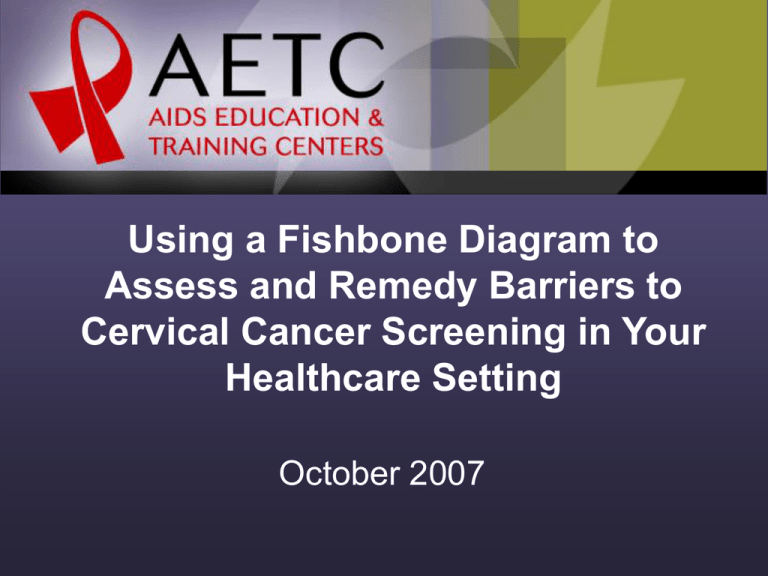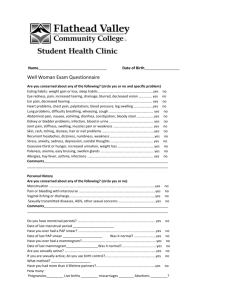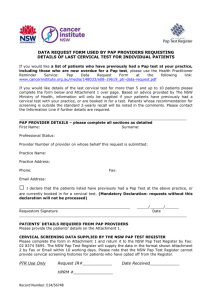Steps in Constructing a Fishbone Diagram
advertisement

Using a Fishbone Diagram to Assess and Remedy Barriers to Cervical Cancer Screening in Your Healthcare Setting October 2007 This slide set was developed by members of the Cervical Cancer Screening Subgroup of the AETC Women's Health and Wellness Workgroup: Laura Armas, MD; Texas/Oklahoma AETC Lori DeLorenzo, MSN, RN; Organizational Ideas Andrea Norberg, MS, RN; AETC National Resource Center Pamela Rothpletz-Puglia, EdD, RD; François-Xavier Bagnoud Center Jamie Steiger, MPH; AETC National Resource Center Other subgroup members and contributors include: Abigail Davis, MS, ANP, WHNP; Mountain Plains AETC Karen A. Forgash, BA; AETC National Resource Center Rebecca Fry, MSN, APN; François-Xavier Bagnoud Center Kathy Hendricks, RN, MSN; François-Xavier Bagnoud Center Supriya Modey, MBBS, MPH; AETC National Resource Center Peter Oates, RN, MSN, ACRN, NP-C; François-Xavier Bagnoud Center Jacki Witt, JD, MSN, WHNP; Clinical Training Center for Family Planning 2 Learning Objectives 1. Describe the rationale for cervical cancer screening and common barriers to completion 2. Discuss the benefits of constructing a fishbone diagram to assess causes of a problem 3. Identify the steps in constructing a fishbone diagram 4. Discuss how the New Jersey HIV Family Centered Care Network successfully used a fishbone diagram to identify and address causes of low cervical cancer screening rates 3 Rationale for Cervical Cancer Screening Abnormal Pap smears are more than 4 times higher in HIV-infected women HIV-infected women have a higher prevalence of HPV infection HIV-infected women are 5 times more likely to develop squamous intraepithelial lesions (SIL) Invasive cervical cancer is an AIDS defining illness Sources: Cervical Dysplasia. In: Coffey S, ed. Clinical Manual for Management of the HIV-Infected Adult, 2006 Edition AIDS Education & Training Centers National Resource Center; 2006:(6) 13-15. Maiman, M. et al. (1998). Prevalence, Risk Factors, and Accuracy of Cytologic Screening for Cervcial Intraepithelial Neoplasia in Women with the Human Immunodeficiency Virus. Gynecologic Oncology, 68, 233 39. 4 Common System Barriers Access to information Missed appointments Childcare Transportation Lack of trained & culturally competent providers Documentation Equipment and exam rooms Fear factor (provider and patient) Referral process 5 Common Cultural & Social Barriers Substance use Intimate partner violence Family history of reproductive cancers Gender roles Discrimination 6 Introduction to Fishbone Diagrams Continuous Quality Improvement (CQI) tool Used to identify, explore, and display the causes of a particular problem Also called a Cause and Effect Diagram 7 Benefits of Constructing a Fishbone Diagram Determines root causes of a problem Encourages group participation Utilizes and increases group knowledge Uses an orderly, easy-to-read format 8 Steps in Constructing a Fishbone Diagram 1. 2. 3. 4. 5. 6. Establish process facilitator and team members Define problem Generate main causes of the problem Brainstorm ideas related to the main causes Interpret results from diagram Identify any causes or ideas where immediate action can be taken 9 Case Study: New Jersey HIV Family Centered Care Network 10 Overview Statewide Ryan White Treatment Modernization Act Part D program Seven sites (e.g., university-based clinics, hospitals, medical centers, and satellite sites) Serves entire State of New Jersey Networkwide CQI process monitors clinical indicators Cervical Cancer Screening Completion Rates 11 First Steps Facilitator and process members Problem Low Pap smear completion rates Main Causes Environment Procedures People Equipment 12 Environment Procedures Lack of support services Limited time for Pap Available services Time Gyn services unavailable on-site Limited time w/ MD/NP d/t large case load Overall clinic time limited Emergencies / unexpected complexity of appt. Co-located srvs not available Not enough clinic space Long wait time Physical space limited Space Space used by other practitioners Walk-in appts. Delay scheduled appts. Have to wait to use exam room Low rate of Pap smears Equipment People 13 Limited time for Pap Environment Lack of support services No policy in place re: referral f/u Procedures Referrals Available services EMR function to flag provider not enabled Referrals are made with no f/u Time Gyn services unavailable on-site Limited time w/ MD/NP d/t large case load Overall clinic time limited Emergencies / unexpected complexity of appt. Co-located srvs not available Not enough clinic space Long wait time Need for Pap Physical space limited Have to wait to use exam room No process to flag need for Pap Limited time to explain procedures Pt. understanding Space Space used by other practitioners Walk-in appts. Delay scheduled appts. Assume pt. is already informed No reminders for pt. appts. Appts. Made without consultation with pts. Appointments No process to remind pts. of appts. Lack of pt. education re: procedure Staff responsibility to provide education not defined Low rate of Pap smears Equipment People 14 Lack of support services Environment No policy in place re: referral f/u Procedures Limited time for Pap Referrals EMR function to flag provider not enabled Available services Referrals are made with no f/u Time Gyn services unavailable on-site Limited time w/ MD/NP d/t large case load Overall clinic time limited Emergencies / unexpected complexity of appt. Co-located srvs not available Need for Pap No process to flag need for Pap Physical space limited Not enough clinic space Limited time to explain procedures Pt. understanding Space Long wait time No reminders for pt. appts. Space used by other practitioners Walk-in appts. Delay scheduled appts. Assume pt. is already informed Appts. Made without consultation with pts. Appointments Have to wait to use exam room Lack of pt. education re: procedure No process to remind pts. of appts. Staff responsibility to provide education not defined Low rate of Pap smears Expectations of staff Expect pt. won’t show Competing priorities and time commitments Assume pt. doesn’t want to do Pap Staff not aware of problems with Paps Don’t want exam Staff Billing may not result in reimbursement Svc. not covered by malpractice insurance Pain Don’t want to perform Pap Negative past experience Pap not in area of expertise Expectations of f/u on results Don’t feel its needed Liability and billing Cost of procedure vs. other needs People Patients Of pain Competing health priorities Too busy taking care of others Equipment Of cancer Of diagnosis Of unknown Unpleasant experience with colposcopy Priorities Fear 15 No policy in place re: referral f/u Procedures Lack of support services Environment Limited time for Pap Referrals EMR function to flag provider not enabled Available services Referrals are made with no f/u Time Gyn services unavailable on-site Limited time w/ MD/NP d/t large case load Overall clinic time limited Emergencies / unexpected complexity of appt. Co-located srvs not available Need for Pap No process to flag need for Pap Physical space limited Not enough clinic space No reminders for pt. appts. Space used by other practitioners Appointments Have to wait to use exam room Competing priorities and time commitments Assume pt. doesn’t want to do Pap Lack of pt. education re: procedure Trained staff Limited funds for equipment Pain Don’t want to perform Pap Don’t feel its needed Liability and billing Cost of procedure vs. other needs People Availability of equipment Negative past experience Pap not in area of expertise Expectations of f/u on results Low rate of Pap smears Staff not trained to use equipment Don’t want exam Billing may not result in reimbursement Staff responsibility to provide education not defined No process to remind pts. of appts. Staff not aware of problems with Paps Staff Svc. not covered by malpractice insurance Pt. understanding Appts. Made without consultation with pts. Expectations of staff Expect pt. won’t show Limited time to explain procedures Space Long wait time Walk-in appts. Delay scheduled appts. Assume pt. is already informed Patients Of pain Competing health priorities Too busy taking care of others Equipment Of cancer Specialty equipment not available. eg. tilting exam table Of diagnosis Of unknown Unpleasant experience with colposcopy Priorities Mobile Pap cart not available Fear 16 Next Steps Brainstorming sessions on fishbone diagram results Discuss successful and unsuccessful strategies implemented in the past Identify new strategies Establish networkwide goal for addressing low cervical cancer completion rates 17 Potential Strategies Document outcome of referrals Use incentives to encourage women to complete Pap smears Raise staff awareness about need for screening Provide cervical cancer screening onsite Create a mobile Pap cart Bring a GYN provider onsite Notify providers about a Pap smear that is due using a prompt Include Pap smears on the color-copied annual assessment form Offer “personal” reminders to patients using phone calls or birthday cards Establish formal policies and procedures for scheduling, completion, and follow-up on Pap smears 18 Implement a Pap Festival Networkwide Goal Seventy percent (70%) of all women will receive and have documentation of a Pap smear on an annual basis. 19 PDSA Cycle Example Problem: Pap rate is still low after staff education and chart audits. Objective: Entice / introduce women into GYN care via Pap Festivals. Plan Set date, identify staff, include consumers, identify resources, plan evaluation Act Need better, more substantial food, alonger, more flexible hours in that day Do Publicize free activity, host Pap Fest, document services, survey patients Study Reactions of the 21 participants, identify barriers and improvements thru brief survey 20 Jersey City Medical Center Example Percents JCMC Pap Rates 90 80 70 60 50 40 30 20 10 0 ? 67 70 2005 2006 52 37 42 2002 2003 2004 2007 Year 21 Lessons Learned and Best Practices Skilled facilitator with knowledge of and experience using fishbone diagrams is essential Manageable number of participants must be selected Broad representation among participants leads to more comprehensive discussion Participation in the process facilitates motivation to tackle the problem Participation in the process facilitates communication about possible remedies to the problem 22 Concluding Remarks Cervical cancer screening is critical for women living with HIV Many barriers lead to low screening rates Fishbone diagrams are useful when identifying causes of a problem After completing a fishbone diagram, follow up discussion can lead to the implementation of useful strategies 23 Helpful Resources A Guidebook on Overcoming System Barriers to Cervical Cancer Screening for HIV-Infected Women In A Clinical Setting Clinical Issues Training of Trainers Package Cervical Cancer Screening and HIV-Infected Women: Pap Smears and Pelvic Exams slide set Human Papillomavirus (HPV) and HIV-Infected Women slide set Common Sexually Transmitted Diseases and HIVInfected Women slide set Resources available at www.aidsetc.org 24 Helpful Resources (continued) AETC National Evaluation Center (NEC) www.ucsf.edu/aetcnec/ National HIV Quality Improvement (HIVQUAL) Project HIVQUAL Workbook: Guide for Quality Improvement in HIV Care http://www.ihi.org/IHI/Topics/HIVAIDS/HIVDiseaseGeneral/Tools/ HIVQUALWorkbookGuideforQualityImprovementinHIVCare.htm National Quality Center www.nationalqualitycenter.og 25 References Abercrombie, P.D. (2003). Factors Affecting Abnormal Pap Smear Follow-Up Among HIV-Infected Women. Journal of the Association of Nurses in AIDS Care, 14(3), 41-54. Anderson, J.R, ed. (2005). A Guide to the Clinical Care of Women with HIV. Health Resources and Services Administration HIV/AIDS Bureau. Brassard, M., ed. (1998). The MEMORY JOGGER: A Pocket Guide of Tools for Continuous Improvement. Methuen, MA:GOAL/QPC. Cervical Dysplasia. In: Coffey S, ed. Clinical Manual for Management of the HIV-Infected Adult, 2006 Edition. AIDS Education & Training Centers National Resource Center; 2006:(6) 13-15. Cetjin, H.E. et al. (1999). Adherence to Colposcopy Among Women With HIV Infection. Journal of Acquired Immune Deficiency Syndrome, 22(3), 247-56. Hirschhorn, L.R. et al. (2006). Gender Differences in Quality of HIV Care in Ryan White CARE Act-Funded Clinics. Women's Health Issues, 16, 104-112. Maiman, M. et al. (1998). Prevalence, Risk Factors, and Accuracy of Cytologic Screening for Cervical Intraepithelial Neoplasia in Women with the Human Immunodeficiency Virus. Gynecologic Oncology, 68, 233-39. New York State Department of Health AIDS Institute. (2000). Promoting GYN CARE for HIV-Infected Women: Best Practices from New York State. Retrieved on July 12, 2007 from http://www.ihi.org/IHI/Topics/HIVAIDS/HIVDiseaseGeneral/Tools/PromotingGynecologicalGYNCareforHIVInfectedWo men.htm Rothpletz-Puglia, P. & Lewis, S. (February 2006) Gynecologic Care and Pap Screening in Ryan White CARE Act Title IV Programs: Summary of Results. Reported submitted to Health Resources and Services Administration HIV/Bureau by HIV/AIDS National Resource Center for Title IV, Francois Xavier Bagnoud Center, University of Medicine and Dentistry of New Jersey. Shuter, J., Kalkut, G.E., Pinon, M.W., Bellin, E.Y., & Zingman, B.S. (2003). A computerized reminder system improves compliance with Papanicolaou smear recommendations in an HIV care clinic. International Journal of STD & AIDS, 14(10), 67-80. The Balanced Scorecard Institute. Basic Tools for Process Improvement Module 5: The Cause and Effect Diagram. Retrieved on July 12, 2007 from www.balancedscorecard.org/files/c-ediag.pdf 26





